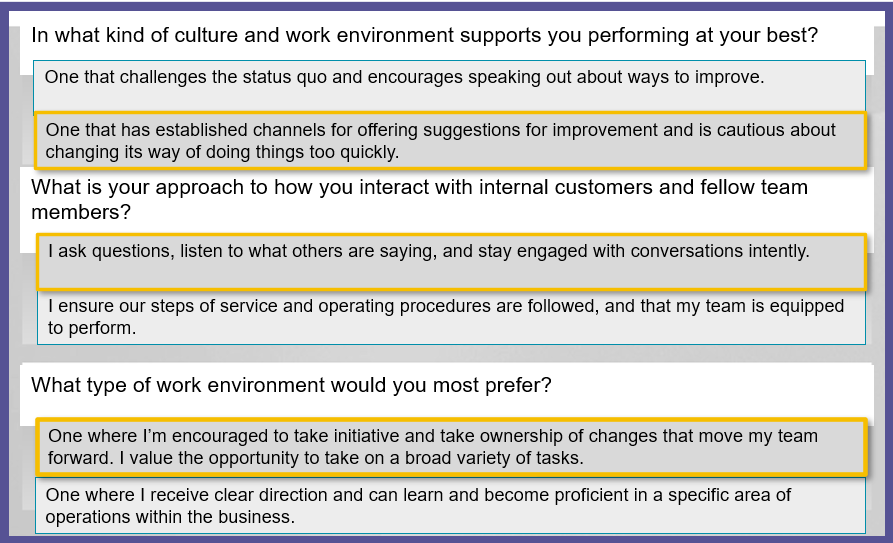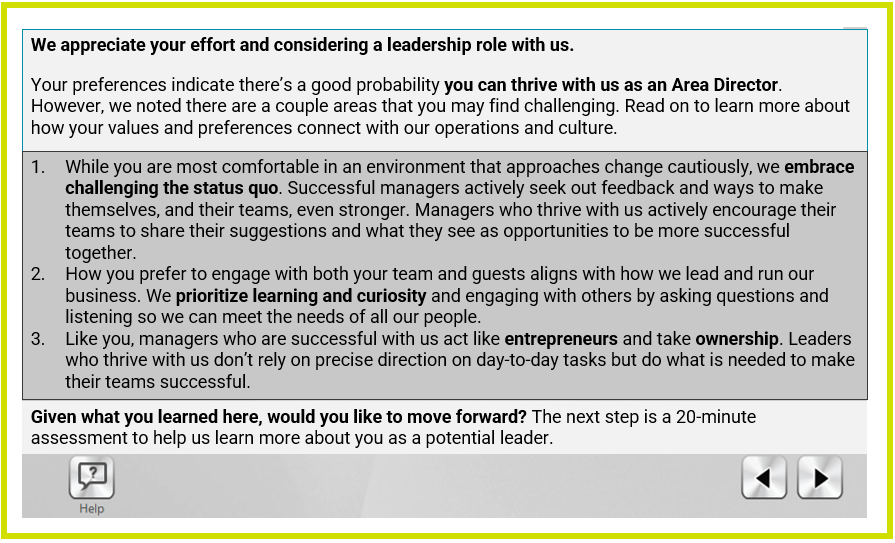Discover how realistic job previews can transform your hiring process and enhance candidate satisfaction and retention in the process.
Bridging The Expectation-Reality Gap
Realistic Job Previews (RJPs) are powerful tools for aligning candidate expectations with the true demands and environment of a job. Job descriptions are designed to attract a broad pool of applicants. RJPs educate and help candidates self-screen early in the process correcting misaligned expectations and preventing disappointment once the candidate begins working.
.png?width=768&height=576&name=Four%20Part%20Diagrams%20-%20blogs%20and%20things%20(1).png)
What information about the job goes into a Realistic Job Preview?
RJPs provide a precise and comprehensive view of responsibilities, challenges, and even work conditions associated with the job. Think about the obstacles and road blocks that most frequently cause disappointment. What aspects of the job and your culture lead to lackluster performance in new hires? This is information that can be used to guide candidates through the RJP experience. Here's a short list of job expectations and qualities we've built into RJPs for organizations across industries:
- Nuts and bolts requirements. hours per week expected, availability, expectations for uniforms; time standing, taking care of customers, travelling. Importantly, the 'why' behind each of these and how it supports your mission can be shared with candidates.
- Cultural values and expectations. Put candidates in what we like to call, critical incidents. These are frequently occurring events that are core to the success of your business. Candidates have several options for responding. These critical incidents could involve your way of working together as a team or supporting your customers.
- Data and Social Proof. Preview materials can share metrics from recent employee engagement surveys, metrics of key results you can share, and employee testimonials (through video or in written form).
Importantly, after responding to these questions, candidates receive feedback on how their performance matches, or falls short, of what your organization is seeking. Candidates are always welcomed to apply after the RJP: even if their responses miss the mark on each criteria.
This is why the RJP is so powerful: its transparency RJP enables candidates to make more informed decisions about whether the often overlooked demands of the role suit them, ultimately leading to greater job satisfaction and reduced turnover.
Below you can see a mock-up of a RJP experience. Candidates share information about themselves and indicate their true preferences. In most cases, the organization choses to never see their responses and this is communicated to candidates. After answering the questions, candidates are shown how their responses connect with the culture, performance expectations, and other demands. Photos and videos showing your unique work environment can also be included.

If this assessment style method seems daunting, consider a checklist, video, or other media that could educate and engage your candidates about your culture, opportunity, and requirements. Shift follows and the opportunity for job shadowing are also stellar opportunities to reap the benefits of delivering a realistic understanding of the position, your operations, and the culture.
Get started: Receive our Realistic Job Preview Toolkit
Companies across industries, including organizations we support in long-term care and retail, have successfully employed RJPs to reduce turnover and improve candidate experience. By immersing potential employees a realistic understanding of what the job involves, we've seen turnover rates fall while building the overall candidate experience. If you read our articles for a bit you'll know wee talk a lot about trust and authenticity in leadership. Earning trust is an uphill journey in recruitment and by sharing direct feedback of the ups and downs of the role, employers build that trust and stand out for their transparency and concern about the success of the new hire. This builds a strong foundation before the candidate's first few, and often challenging, months on the job begin.

The effects of these RJPs aren't negligible. Realistic Job Previews have contributed to-
When researchers study the impact of realistic job previews the impact of this short pre-hire experience carries a meaningful buffer against stress and strain on the job on top of increased job satisfaction and retention. Consider how RJPs have -
- Reduced trauma post-hire in emotionally demanding roles. For caregivers in residential treatment centers not only built retention and greater commitment to the job and organization, but reduced psychological strain in the months, and years, after hire.
- Lowered unit-to-unit turnover for newly licensed nurses. When nurses completed a RJP sharing key information about a potential unit choice (e.g. emergency, labor and delivery) they made better and more informed decisions leading to greater engagement and less requests for reassignment later.
- Increased job satisfaction by over 20 percent.
- Reduced turnover by 9 percent or more.
- Improved perceptions of honesty, transparency, and trust of the potential employer.

Enhancing Candidate Fit and Retention
Finding candidates that live your culture, perform, and hold the potential to stay long-term is never a final destination but always a journey. In other words, the cultures of our businesses and the nature of our enterprise will always be evolving, as will the job market. RJP experiences are a low-cost opportunity to reinforce not only your expectations, but attract candidates who align with both the job requirements and the organizational culture.
Almost anyone with more than a year or so of work experience can attest to the frustration and loss of productivity stemming from turnover; a hire that's well-intentioned but not a fit for the role. Early turnover and churn are especially pernicious. Realistic Job Previews (RJPs) help us prevent this by offering a transparent and honest portrayal of the job and company culture. We can make the process even more powerful by reinforcing key points from the RJP in the interview (fantastically easy to make happen with structured interviewing). This provides a consistent drumbeat and multiple touchpoints reinforcing the key parts of your culture, job expectations, and operations.
It's not just about screening out those who aren't a great fit. Your openness allows candidates to more fully envision their potential role and and contribution, resulting in better connection between the employee and the organization.
Marrying Hiring Assessment Tools with Realistic Job Previews
Our potential to perform can be understood through a crayon-simple equation that industrial-organizational psychologists are quite fond of:
Performance = Ability x Motivation x Opportunity
- Good news: we have the basics of the opportunity locked up. You're hiring! However, opportunity extends to the resources and constraints inherent to the job. This may bring to focus information to communicate when you're thinking about your recruitment process, interviewing, and RJPs.
Let us give a few examples. Some companies may operate with a lean mindset, or a generalist perspective for a role. They may expect salespeople to qualify their own leads. Consultants are expected to format their own presentations and materials. In a restaurant, a server may not have an assistant to support them. Maybe your enterprise operates without, a piece of key technology, equipment or resources candidates may expect. This would be useful to incorporate in your realistic preview - whether an assessment, shift follow or shadow, or video.
- Ability is aptly screened through hiring assessment tools like psychometric assessments. Starting with an understanding of the core competencies of the role is wise to use as a guiding framework. Psychometric assessment tools for hiring give us a view of potential whether that's the ability to problem solve or the personality and interconnected qualities needed for customer service. Competencies are meaningful not only for accurately selecting the assessments that best predict performance and hiring decisions but are also a solid framework for building a RJP as we can educate candidates about the unique constellation of interests, preferences, and values that are linked to success in the role.
- Now to motivation. RJPs broaden our aperture to gauge interest and drive. They complement what's understood from psychometric assessment tools. Attention to detail, gauged by a personality assessment or interview, can be one of my strengths, but will I enjoy applying that in your unique environment? While we both possess a keen attention to detail, one of us (Jennifer!) struggles to execute this in live production environments (think situations where a customer is directly in front of you needing a service or product). If you think about your own preferences and strengths, and that of your colleagues, it doesn't take long to found boundary conditions where their strengths are thwarted by the demands of a situation.
The case for a realistic culture preview
Companies like Southwest Airlines, with a unique employee and customer value proposition, built hiring efficiency, and retention, through candidly educating candidates about their mission and culture. In competing with United Airlines, Delta Air Lines, and American Airlines, Southwest prioritizes its organizational culture as a strategic competitive key for operations and organizational efficiency. Through its values and beliefs, the company tackles the competitive environment by focusing on its mission, care for people, and a strong focus on celebration and recognition. From their culture statement -
People come first. We’re a Company that takes care of its People and its communities, and our People take care of each other. (We’re Cohearts, after all!)
Our unique Southwest® Culture is woven into all aspects of our business, from how we treat each other to how we provide Next-Level Hospitality to our Customers.

By offering candidates a realistic perspective of the job and company culture at each touchpoint, Southwest Airlines has successfully attracted and retained employees who can live their values and expectations than those that choose industry peers.
Setting the Right Expectations
Enhancing the candidate experience through RJPs drives positive outcomes in employee retention and satisfaction. When candidates clearly understand what to expect from their roles, they are more likely to feel confident and prepared upon joining the company. We've talked about the 'honeymoon hangover' where the excitement of a new opportunity dissolves and we're confronted with the excessively rose-colored glasses we've been wearing.

This confidence translates into higher levels of engagement and job satisfaction, as employees feel more supported, valued, and know what will be expected of us. By prioritizing transparency and equipping candidates with the information they need to make informed decisions, companies can foster a more positive and supportive work environment - from their first touchpoint with an employee.
Reducing Recruitment Costs and Time
As we write this the labor market is slowing down, more in some industries than others. Employees feel a little stuck, and that new opportunities may not be as wide ranging as they were just six months ago. A 'stuck' labor market means candidates might jump at any opportunity that comes their way. A strong candidate experience that focuses not just on screening, but also educating applicants about the opportunity can push back on the tendency for them to take any opportunity that heads their way.
High turnover rates can greatly affect a company's financial health, leading to increased expenses related to recruiting, hiring, and training new staff. Job previews help alleviate these costs by increasing the degree to which the candidate pool is informed and genuinely interested in the recruitment process. By offering a clear and honest portrayal of the job and company culture, RJPs allow candidates to make better-informed decisions about their suitability for the role.
Reduce spend, time to hire, and time spent hiring
This efficiency reduces the time and resources spent on hiring, as fewer unsuitable candidates join the workforce. For instance, a cost-benefit analysis by a major retail chain showed that using RJPs implementing RJPs led to significant cost savings in recruitment and training expenses. This highlights the tangible return on investment that effective hiring processes can offer, emphasizing the role of RJPs in lowering turnover and boosting overall organizational efficiency.
Boosting Employee Engagement and Commitment
A strong connection exists between job satisfaction and employee engagement, with realistic job previews setting the stage for engagement and enduring commitment. By setting clear expectations from the beginning, RJPs pave the path for positive employee experiences. This clarity allows new hires to feel more confident and engaged in their roles, as they gain a better understanding of what to anticipate and how to excel. When employees are aware of what they are entering into, they are more likely to align with the company’s goals and values, boosting their overall engagement and commitment.
Measuring the impact of RJPs and the candidate experience
We're best set up for success when we have a clear definition of what we want to achieve and a plan to measure it. While post-hire assessments of engagement and satisfaction generally reveal that employees who have undergone an RJP process show stronger commitment and performance, we want to know this is the case for our own organization. In this case, candidate experience surveys are a low-cost and actionable way to not only understand how the RJP is functioning but other aspects of our hiring process like assessments, communications and even your applicant tracking system.
Consider assessing engagement and retention post-hire and comparing results before and after implementing the RJP. The significance of collecting and acting on candidate feedback cannot be overstated. By continually refining the RJP process based on feedback from new hires, companies can ensure they are offering the most accurate and beneficial information to prospective employees. This iterative approach not only enhances the candidate experience but also contributes to a more engaged and satisfied workforce. Costing around the hiring process before and after RJP implementation supports the spend and time invested and also gives you confidence the solution works as intended.
Building a Transparent and Trustworthy Employer Brand
Transparency is core to a robust employer brand, and job preview tools significantly enhance employer credibility by demonstrating honesty and openness about job roles. By providing clear and precise information about job responsibilities, companies set realistic expectations for potential hires. This transparency builds trust and goodwill among candidates, making them feel more informed and respected during the recruitment process. By being candid about the challenges and rewards of a position, employers can cultivate a reputation for integrity and reliability, which are essential elements of a strong employer brand.
The long-term advantages of this transparency are substantial. When potential hires believe a company is honest about its job roles, they are more inclined to see the organization as an attractive place to work. This positive perception can attract a larger pool of high-quality candidates who are genuinely interested in the company and its values. Over time, this can lead to a more engaged and committed workforce, as employees who join with a clear understanding of their roles are more likely to feel satisfied and aligned with the organization’s objectives.
Case studies of companies with robust RJP practices, like Patagonia, demonstrate how a dedication to transparency can create a more trustworthy and appealing employer brand. Patagonia, renowned for its strong environmental and social values, uses RJPs to ensure potential hires fully grasp the company’s mission and role expectations. This strategy has helped Patagonia attract candidates who are not only skilled but also passionate about the company’s values, resulting in a more cohesive and motivated workforce. By emphasizing transparency, Patagonia has bolstered its employer brand, making it a sought-after employer in the competitive job market.
RJPs are a potent tool for building a strong employer brand. By offering potential hires a realistic perspective of job roles, companies can boost their credibility, foster trust, and attract top candidates. This dedication to transparency not only enhances the recruitment process but also contributes to long-term organizational success by ensuring new hires are well-informed, engaged, and aligned with the company’s values.
Steps to Implementing a Realistic Job Preview
Implementing an effective RJP requires a thoughtful approach. Start by assessing your current recruitment process to identify areas for improvement. Where are both candidates and hiring managers experiencing unpleasant surprises?
Highlight key job elements that should be featured in the RJP, whether through an experiential assessment, video, job shadowing, or detailed written descriptions. Next, train hiring managers and recruiters to maximize the RJP. Finally, evaluate the effectiveness of your RJPs through feedback and metrics to ensure they are meeting their objectives. As your operations change and grow RJPs can be adjusted to reflect your workforce. RJPs can cut job advertisement spend, reduce hours spent on hiring and recruiting, and prevent people from going down a road that will bring them frustration and pain. Take this simple step to build a stronger applicant pool and support the well-being and success of your new hires.
Featured image by Getty Images for Unsplash+







